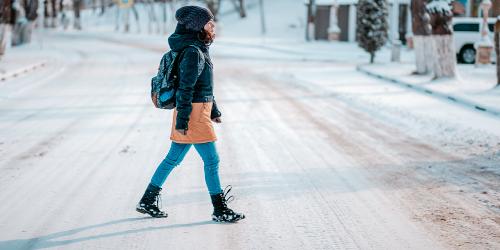Pedestrians are more vulnerable to injury in winter and early spring in Alberta due to the accumulation of snow and ice on roadways and sidewalks and surprise “second winter” events. If you or a loved one suffers a fall and gets injured, you may wonder if there is a right to compensation, and who to address your claim to.
Liability for injuries suffered in outdoor slip and fall accidents is governed by either the Municipal Government Act or the Occupiers’ Liability Act, depending on who has care of the property where the accident occurs.
Accidents on Municipal Sidewalks
In most cases, municipalities bear ultimate liability for slip-and-fall injuries resulting from snow or ice on sidewalks. Notice must be given to the municipality of a claim against it within 21 days after the occurrence of the event. Note, however, that under the Municipal Government Act, a municipality is only liable for an injury to a person or damage to property caused by snow, ice or slush on roads or sidewalks if the municipality is grossly negligent.
Some decisions from the courts have helped to illustrate when a municipality may or may not be liable.
In Grabczewski v. Edmonton, a 1984 case, the municipality was liable for injuries suffered by the plaintiff after she was run over by a bus. The plaintiff had crossed the street and been unable to get off the street onto the curb due to a buildup of ice and snow on the edge of the sidewalk, which the municipality had allowed to accumulate for some time.
However, in a 2021 case, Pecanac v Camrose (City), the plaintiff was walking to work on her regular route when she encountered an icy and “impassable” patch of sidewalk. To avoid the icy patch, she stepped onto a municipal lane where she slipped on black ice and fell. The municipality successfully relied on sections 530 and 531(1) of the Act to have her personal injury claim dismissed. There was no obligation for the municipality to attend to the particular stretch of sidewalk or lane where the accident occurred, or to perform spot checks or inspections. Environmental records showed it was possible that the slippery patch was caused by precipitation the evening prior to the accident, which meant that no municipal employees were on duty and capable of discovering the hazard prior to the accident.
Accidents on Business Premises
Slip and fall accidents on private property fall under the Occupiers’ Liability Act. Under s. 5 of the Act, an occupier, such as a business or property owner, has an affirmative duty to take reasonable care for the safety of people who are permitted on their premises.
All property owners or renters must proactively clear ice and snow. Snow contractors are often contracted for the removal of snow and ice and the maintenance of the property. Both the owner/occupier and the contractor could be liable for a breach of the duty of care. Claims made under the Occupiers’ Liability Act are subject to the standard limitation period for negligence claims, which means you have two years to file a legal action.
Once again, decisions from the courts help to illustrate circumstances where liability for a fall may or may not be found.
In Saunders v. Calgary (City), where the plaintiff slipped and fell in an area between the parking lot and community centre on premises occupied by the defendant community association, the plaintiff’s action against the defendant was allowed. The defendant had no written snow removal policy, and the path used by the plaintiff was not cleared. The defendant was obliged to make the parking lot reasonably safe and did nothing to meet its obligation.
In Hannam v. Medicine Hat School District 76, a 2020 case, the plaintiff slipped and fell on a sidewalk outside a school moments after the school custodian had sanded it. She was walking behind the school custodian while he was spreading sand. The Court of Appeal found the defendant was not negligent. There was nothing more the defendant should have done to make its sidewalk safe for visitors.
In Koch v. Slave Lake Jewellers Ltd, a jewellery store in a strip mall was found not to be an occupier of the sidewalk in front of the store, and therefore was not liable for the plaintiff’s fall. The store had no control over the activities conducted on the sidewalk or the persons allowed to enter the sidewalk. A common law duty of care did not arise simply because store employees sometimes cleared and cleaned the sidewalk or by fact that the plaintiff was entering the store.
Accidents in Residential Areas
The owners of residential properties are not considered to be occupiers of municipal sidewalks. Bylaws in Edmonton and Calgary require homeowners to remove snow from sidewalks adjacent to their property. However, absent special circumstances, property owners are not liable for slip and falls on sidewalks adjacent to their properties.
Even breach of a by-law to shovel snow on a public sidewalk cannot, by itself, form the basis of liability. Additional elements of occupation or control by the property owners or special circumstances creating an unusual risk or nuisance must be present.
For example, a 2006 case, Durech v. Schneider, found that water flowing onto a municipal sidewalk from a residential property might give rise to special circumstances that would impose liability on the property owners.
By contrast, in the 2001 case of Kluane v. Chase, the plaintiff fell on a city sidewalk in front of a property owned and occupied by the defendants. The sidewalk was icy but was shovelled, sanded and salted by the defendants. In addition to finding that the bylaw did not establish civil liability on the defendants for failing to remove ice and snow, there were no special circumstances justifying a common law duty of care. The icy sidewalk was not caused by the conduct of the defendants.
More recently, in the 2019 case of Lewandowska v. Vander Woude, the plaintiff slipped and fell on snow and ice while walking a dog on a municipal sidewalk adjacent to the driveway of the defendants’ property. The plaintiff’s evidence failed to establish that the defendants allowed or created conditions or activities on their property that flowed onto the sidewalk. Driving back and forth over the sidewalk causing the packing down of snow was not a special circumstance that created an unusual risk or nuisance.
Could You Be Liable for Your Own Injuries?
In some cases, pedestrians have been found to be contributorily negligent for their own injuries. This may happen where a pedestrian has in some manner failed to take reasonable care for his/her own safety. We have discussed contributory negligence in more detail in this previous blog post.
For example, pedestrians have obligations while walking in winter weather to wear appropriate footwear, walk at a normal pace and to be aware of the conditions. Betteridge v. School Children Co-Operative Centre, a Saskatchewan case, found that an invitee did not use reasonable care in wearing smooth-soled dress shoes, rather than winter boots.
In another Saskatchewan case, Sweeney v. Prince Albert (City), the cause of the plaintiff’s accident was her decision to use the narrow meridian or divider as a stepping stone in order to get into a van. No negligent conduct of the defendants caused or contributed to the accident.
What to Do if You Have a Slip and Fall Accident:
If, despite taking reasonable precautions, you slip and fall on ice or snow, there are a few things we recommend you do:
- While a person’s natural instinct after a slip and fall is to get up, it is best to take a moment and check your body for pain or injury.
- If you are able to do so, start documenting where you fell by taking pictures and collecting witness information.
- Make note of the date, time and weather conditions.
- Notify the property owner as soon as possible. If you’ve fallen on a municipal sidewalk, you must notify the municipality of the fall within 21 days. If you’ve fallen on a retail property, make sure you notify the manager of the property and make an incident report.
- Keep track of footwear worn at the time of the fall, as footwear is always considered in slip and fall cases.
CAM LLP Experienced Personal Injury Lawyers
Speaking with a personal injury lawyer can help determine if you are entitled to compensation. Personal injury lawyers can determine potential liability by analyzing whether property owners, municipalities, or other parties may be responsible for the conditions leading to the accident and any resulting injury.
If you or a loved one have suffered injuries in a slip and fall accident, contact us for a free consultation. We are here to help you.

